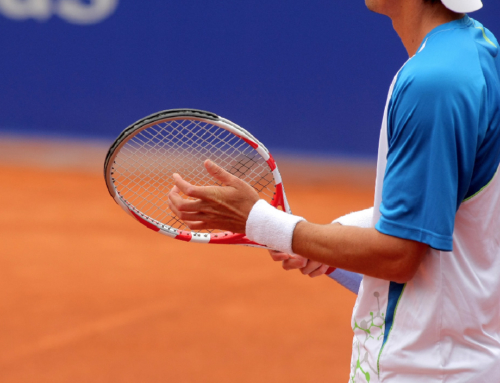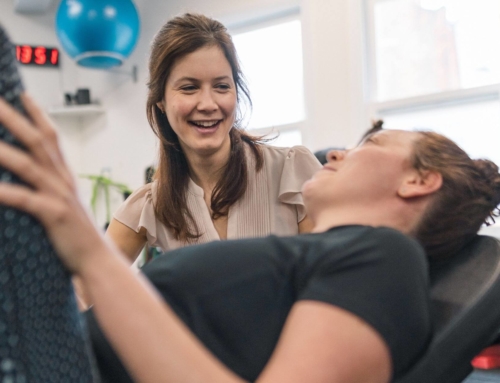I felt my calf ‘pop’, what does it mean?
Imagine this scenario: you’re in the middle of a crucial game of tennis; you’re about to win the first set, when your opponent plays a sneaky drop shot and you have to sprint to the net. Suddenly you feel an intense, sharp, shooting pain in the back of your calf and hear a disconcerting pop!
Disaster! That’s it, game over, you’re hobbling off court, hardly able to put any weight on your leg, and wondering if you’ll ever make it back on court again!
The ‘pop’ you felt or heard, usually means that you’ve torn a part of the calf muscle. This common injury is known as ‘Tennis Leg’, it is a tear in the medial head of the gastrocnemius muscle (calf muscle).
It’s obviously not just tennis players who experience this injury, it can happen to anyone involved in explosive sports which require acceleration, deceleration and quick changes of direction. It is not uncommon in football, rugby, hockey and running, particularly sprinting.
In this blog we will discuss the causes and symptoms of tennis leg and how it is diagnosed and treated.
Before you read on, be 100% sure you have not ruptured your Achilles!
It is important to rule out something more significant such as an Achilles rupture. An Achilles rupture will be felt further down towards the heel bone. You will likely notice significant bruising on the calf muscles and/or a palpable gap in the achilles tendon.
Vector Illustration Achilles Tendon Rupture Image Stock Vector (Royalty Free) 310462301 | Shutterstock
It is essential that if you think you have ruptured your Achilles, that you get urgent medical attention. Poor early management of an Achilles rupture can cause a long-term impairment.
At Complete we are highly experienced in assessing Achilles ruptures; you must see one of our expert physiotherapists if you suspect you have damaged your Achilles – believe it or not we have seen these missed by other healthcare professionals and even doctors in A & E!
ALSO, if your calf is very painful, swollen and red then you may have a blood clot known as a deep vein thrombosis (DVT). This requires urgent medical attention at A&E.
Anatomy of the calf muscle
The gastrocnemius muscle is the most superficial muscle of the calf, making it prone to injury, especially in older athletes.
Unlike a typical calf muscle tear, which happens within the muscle fibres, this occurs in the tendon (Aponeurosis) which separates the medial (inside) head of the gastrocnemius and the soleus muscle.

(Image from Radsource)
What causes a Tennis Leg?
The usual mechanism of this calf injury is one of high force such as a run, sprint or rapid change of direction or pace.
It may also happen if the calf is overstretched such as landing from a jump. Patients often describe a popping sensation felt in the middle of the calf.
Although it is an injury that can happen at any age, middle-aged males are most prone to tennis leg. As we age our muscles slowly atrophy (weaken) and tendons start to degenerate and lose their elasticity. Even if we have kept fit and competed at high-level sport when we were younger, the likelihood is that working long hours (especially desk based work) has caused a dip in activity levels and fitness condition. This pattern of inactivity during the working week, followed by sporadic bursts of higher intensity activity at the weekends, is the perfect recipe for injury!
There are other conditions that can mimic a tennis leg and may have a similar mechanism of injury, such as an Achilles Tendon rupture. These conditions can occur separately or alongside each other at the same time.
If you have felt a ‘pop’ in the calf you should see one of our expert physiotherapists asap. This is a more severe injury than a typical calf muscle tear and needs accurate diagnosis and more specialised treatment. The team of physiotherapists at Complete have extensive experience of treating calf injuries in both elite/professional athletes to more sedentary individuals.
What are the symptoms of tennis leg?
Someone who is suffering from a tennis leg usually describes a very specific incident of injury, and a feeling of being ‘shot’ in the leg. It can be hard to determine exactly the site of pain but towards the middle and upper third is usual.
A bruise very often develops along with some swelling. The area of the injury will be tender to touch and you may not be able to walk on it, or may only be able to walk on your toes. Stretching the calf will cause increased pain.
The following are the most common symptoms of a tennis leg:
- Pain on walking, especially with longer steps.
- Inability to run, hop or jump or pain during these movements.
- Pain when pressing on the calf muscle.
- Swelling in the calf region.
- Bruising – If bruising and swelling is severe, it might be that you have developed a haematoma.
- Pain and weakness when trying to go onto tiptoes
These symptoms are not isolated to a tennis leg; as mentioned earlier, there is significant overlap with other conditions in the calf and ankle including more serious conditions such as Achilles Tendon rupture and deep vein thrombosis (DVT).
Immediate management if you have felt a ‘pop’ in your calf
Your physiotherapist may decide a ‘heel raise’ in the shoe is sufficient to reduce pain and encourage optimal healing. Thus decision can only be made once you have bene properly assessed.
The first thing to do is to offload the leg and calf as much as possible.
- Reduce your walking to a bare minimum until you obtain a diagnosis – it is important to rule out an achilles tendon rupture.
- If you are limping and pain is very severe then you may require crutches for a few days, or could purchase a walking boot which will take the pressure off the region and reduce your pain. You may need to do both. Being more conservative at the start will help in the long run.
- Elevate your leg as often as possible when resting to reduce swelling
- It can also help to ice and compress your calf in the first 48-72 hours. (It is important that the compression is not too tight and that you do not burn yourself with ice; ice burns just like heat!)
- Do not stretch the calf. This will not encourage the tissue to heal in the early stages.
When should you see a physiotherapist for Tennis Leg?
It is strongly recommended that you see a physiotherapist as soon as possible after the injury to get an accurate diagnosis and rule out anything more serious. In the first few days the treatment will consist mostly of advice on what to do and what to avoid. The earlier these injuries are managed professionally the better the chance of recovery and less likelihood of re-injury.
Physical Assessment
Your physiotherapist will carry out an extensive physical assessment, to locate the source of your symptoms and why they may have occurred.
It will likely include:
- Observation and palpation of the calf muscle to look for increased heat, swelling, bruising or change in calf muscle shape
- Ankle and calf range of movement
- Calf strength testing – can you stand on one leg or perform a heel raise?
- Gentle palpation (feeling) of the calf complex to locate areas of discomfort
- Walking assessment
Do you need a scan for Tennis Leg?
If you have an incident when you feel a ‘popping’ sensation and have the symptoms above, then it would be wise for you to have a scan.
The choice of scan for this is a diagnostic ultrasound scan. A diagnostic ultrasound scan is superior to an MRI for Achilles, and calf injuries of the aponeurosis and gastrocnemius. We can determine the extent of the injury more accurately, and it also provides information regarding whether or not there is a haematoma (fluid collection – see image below) in the calf; a common occurrence with this injury.
On your first appointment, our Clinical Specialists at Complete will carry out a scan as part of their initial assessment (at no extra charge).
You will receive a full report following your scan and a management programme to get you back to full function. They will also determine whether any fluid found should be aspirated (drained) to help with pain levels and healing of the tear.
You will need to inform us at the time of booking that this is what you need, so that you can be booked in with the correct team member.

The ultrasound image shows a tennis player’s ‘tennis leg’ in July. Draining the fluid immediately helped the pain. The injury took 2 months for him to return to the court following a course of physiotherapy at Complete Physio
If there is a fluid collection in the muscle, do you need it drained (called an aspiration)?
In our experience, draining excessive fluid will improve the healing outcome of these injuries by allowing the two ends of the tear to knit back together. It is a bit like a ‘zip’ which has been pulled open and the gap fills with fluid, draining this helps the muscle fibres to close and heal. Draining the fluid also significantly reduces the pain and discomfort you will feel in the calf from the excess swelling and pressure.
This procedure must be carried out using ultrasound guidance and ideally within the first 4 weeks. After 4 weeks the fluid may have solidified, so it cannot be drained. These time frames do vary.
If the injury requires draining (aspirating) this can also be carried out. There will be an extra cost for this procedure. If you require an ultrasound scan and potentially this procedure you must book in with one of our clinical specialists.
If you would like to discuss your injury before booking an appointment, please email info@complete-physio.co.uk and one of our clinical specialists will call you back.
What is the recovery time for Tennis leg?
As with most sports injuries, recovery from a tennis leg injury will depend on several factors including:
- The severity of the injury
- The pre injury fitness level of the patient
- How closely the patient adheres to the recommendations and treatment
It’s common for these injuries to feel painfree within a couple of weeks, but that does not mean the calf has healed sufficiently for you to return to sport. This can give you a false sense of security and you may return to sport too soon. If you re-injure yourself you are at risk of a more significant injury than the initial one.
Having said this, if you seek timely intervention and rehab goes smoothly, most individuals with a mild to moderate injury can usually resume normal activities within 4-6 weeks of the injury. More severe injuries can take up to 12 weeks to fully heal.
What does physiotherapy and rehabilitation involve for Tennis Leg?
Here at Complete we have all the expertise, rehab facilities and equipment to help you recover from such an injury. We have a team of specialist physiotherapists who have worked with elite athletes who will manage your return to sport.
From initial diagnosis to late-stage rehab, a stepwise approach will be taken to guide your safe return to your pre-injury level of activity and return to play.
Broadly speaking the rehab can be broken down into 3 main phases.
- Acute phase – as mentioned above the early management involves rest, offloading, possible immobilisation, ice and compression. Aspiration if warranted based on your ultrasound scan.
- Middle stage – your physiotherapist will guide you through a series of exercises involving stretching and strengthening the calf muscles. Early stretching is to be avoided, however once full range of movement is restored and your pain has settled, it can be started. The most important part of this phase is a progressive strengthening program for the calf muscle. Initially this will be with body weight and then will progress to using weights. At this stage reintroduction into some sporting activities such as cycling, swimming or cross-training can begin, but will usually be limited to low weight bearing exercise.
- Late phase – once adequate strength has been achieved within the calf, you will start to reintroduce impact work such as plyometric (jumping/hopping) exercises in preparation for running. You will also begin to challenge the calf by adding some acceleration and deceleration activities, and lateral, change of direction drills. Your physiotherapist will design a program to suit the demands of your specific sport of activity, to ensure you are focusing and being challenged on key elements of that sport.
Key points to remember if you feel a ‘pop’ in your calf.
- You should be seen by one of our expert physiotherapists asap to get the correct diagnosis and ensure you are managed correctly. Many injuries can present with similar symptoms – but some are more serious and must not be missed, such as an Achilles tendon rupture.
- You may require a diagnostic ultrasound scan to confirm the diagnosis and extent of your injury. At Complete we do not charge for an ultrasound scan. Ensure you are booked in with one of our clinical specialists if you think you need an ultrasound scan.
- Large tears often have a haematoma i.e., fluid between the two muscles. This is easily visualised on an ultrasound scan. Draining (known as ‘aspirating’) the fluid can help speed up the healing and reduce pain.
- It is important that before you return to sport that you are checked out by one of our physiotherapists. It is not uncommon for the pain to reduce in a couple of weeks but for the healing to be incomplete. If this is the case, the injury may reoccur. A second injury is likely to be more severe than the original injury and will take longer to heal.
- Every injury and individual is different, and working with a physiotherapist who has experience with these injuries is essential for a successful outcome.
At Complete Physio we are experts in the diagnosis, treatment, and management of calf tears. For more information, please contact us on info@complete-physio.co.uk or call 020 7482 3875.
Don’t let pain hold you back, book now!




